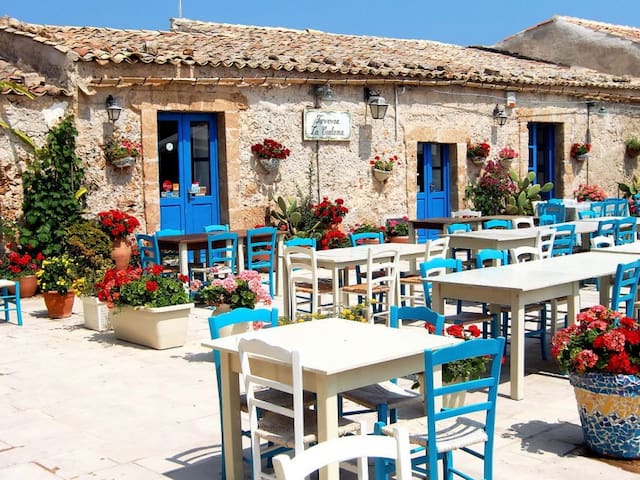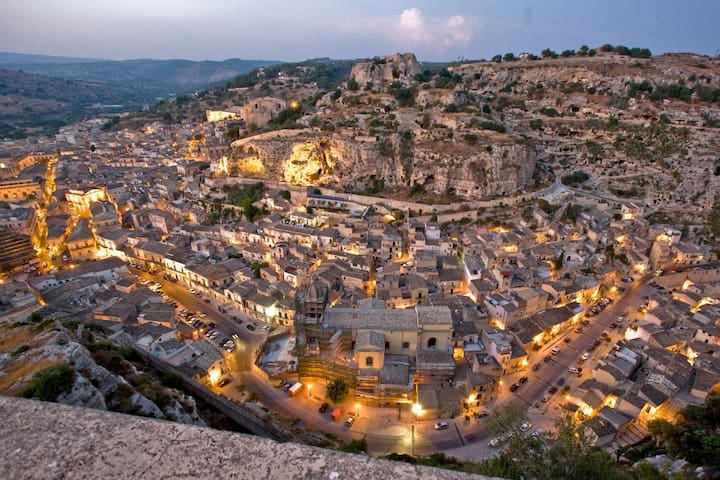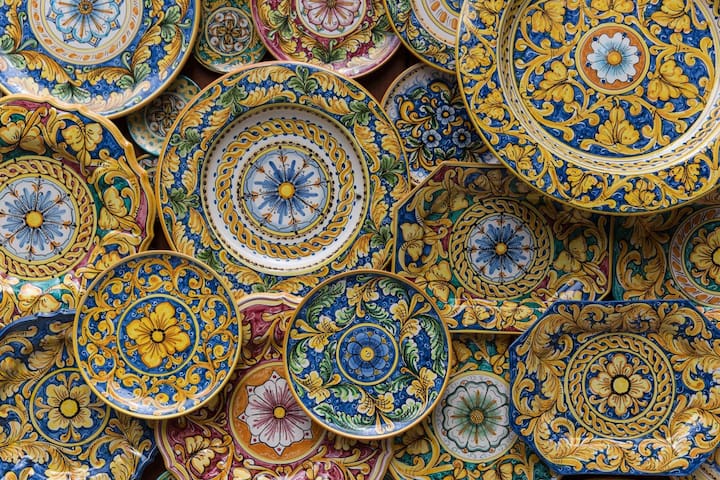Visite turistiche
Discover the enchanting places around Villa Le Girandole!
15 minutes far from Villa le Girandole, Siracusa is one of the richest cities in terms of culture and history of the whole Sicily, and it has been for ages the crucial centre of the entire province. The city is famous for the Greek colonizations, which are clearly reflected on the cultural heritage, and can be admired on the anphitheathers and on the architecture, especially walking through the enchanted Ortigia.
Since 2005, Siracusa with the Necropoli of Pantalica is inserted in the World Heritage Site of UNESCO, because "monuments and archeological sites located in Siracusa are the most amazing example of extraordinary architectual creation which huge various cultural aspects: Greek, Baroque and Romans".
418 místní doporučují
Ortigia
15 minutes far from Villa le Girandole, Siracusa is one of the richest cities in terms of culture and history of the whole Sicily, and it has been for ages the crucial centre of the entire province. The city is famous for the Greek colonizations, which are clearly reflected on the cultural heritage, and can be admired on the anphitheathers and on the architecture, especially walking through the enchanted Ortigia.
Since 2005, Siracusa with the Necropoli of Pantalica is inserted in the World Heritage Site of UNESCO, because "monuments and archeological sites located in Siracusa are the most amazing example of extraordinary architectual creation which huge various cultural aspects: Greek, Baroque and Romans".
Noto: this small town in the south-east was founded again in the 1700’s. It is the heart and at the same time the starting point for a visit to the valley of the Sicilian Baroque. Its cathedral, also perfectly raised and rebuilt again after 10 years of difficult work, was included in the UNESCO World Heritage Sites.
771 místní doporučují
Noto
Noto: this small town in the south-east was founded again in the 1700’s. It is the heart and at the same time the starting point for a visit to the valley of the Sicilian Baroque. Its cathedral, also perfectly raised and rebuilt again after 10 years of difficult work, was included in the UNESCO World Heritage Sites.
Marzamemi is a sea town between Pachino and Noto. It is included in the district of Syracuse. From Pachino, the distance is 3 kms, while from Noto, the distance is 20 kms. It is also regarded as one among the most beautiful 20 sea towns of Italy. The main attractions of this town are the tasty fish recipes served by picturesque restaurants, the amazing sight of the sea, the narrow alleys and buildings that remind us a medieval county, and “The Tonnara”. This is the name of the grid that the local fishermen use to catch several samples of red tuna that is immediately sold to restaurants. The Tonnara is also an ancient palace that in the past served to shelter the great ships used to fish tuna . Over the years, it has been turned into an evocative restaurant and a suite with a stunning sight on the sea. However, Marzamemi is also a Sicilian town with a strong tourist relevance, where you can discover a quiet and wonderful landscape, an untouched nature and the impression that time has stopped forever.
478 místní doporučují
Marzamemi
Marzamemi is a sea town between Pachino and Noto. It is included in the district of Syracuse. From Pachino, the distance is 3 kms, while from Noto, the distance is 20 kms. It is also regarded as one among the most beautiful 20 sea towns of Italy. The main attractions of this town are the tasty fish recipes served by picturesque restaurants, the amazing sight of the sea, the narrow alleys and buildings that remind us a medieval county, and “The Tonnara”. This is the name of the grid that the local fishermen use to catch several samples of red tuna that is immediately sold to restaurants. The Tonnara is also an ancient palace that in the past served to shelter the great ships used to fish tuna . Over the years, it has been turned into an evocative restaurant and a suite with a stunning sight on the sea. However, Marzamemi is also a Sicilian town with a strong tourist relevance, where you can discover a quiet and wonderful landscape, an untouched nature and the impression that time has stopped forever.
1 hour far from Villa le Girandole, Ragusa is one of the 7 provinces of Sicily. The city develops on the south side of Iblei’s mountains and it is southern administrative center of Italy. It has been called the “island in the island” for its historic and socio-economic characteristics that makes it different in comparison to the whole Sicily. After the strong earthquake that destroyed the city in 1693, the following reconstructions divided the “upper” Ragusa, located in the upland, to the Ragusa Ibla, risen in the ruins of the ancient city.
The architectural masterpieces built during this era have been declared World Heritage Site of UNESCO, together with the ones in Val di Noto, for the marked testaments of Baroque arts.
272 místní doporučují
Ragusa Ibla
1 hour far from Villa le Girandole, Ragusa is one of the 7 provinces of Sicily. The city develops on the south side of Iblei’s mountains and it is southern administrative center of Italy. It has been called the “island in the island” for its historic and socio-economic characteristics that makes it different in comparison to the whole Sicily. After the strong earthquake that destroyed the city in 1693, the following reconstructions divided the “upper” Ragusa, located in the upland, to the Ragusa Ibla, risen in the ruins of the ancient city.
The architectural masterpieces built during this era have been declared World Heritage Site of UNESCO, together with the ones in Val di Noto, for the marked testaments of Baroque arts.
Modica is an attractive historic town in south-eastern Sicily, one of the area's UNESCO-listed Baroque towns. Modica is particularly famous for its chocolate, and it is an appealing destination for food-lovers, making a good holiday base or day-trip destination.
Modica is situated in the dramatic landscape of the Monti Iblei, a range of high ground divided up by deep valleys and surprisingly populous towns. Important in Medieval times, Modica was rebuilt after the great earthquake of 1693 and now boasts fine late-Baroque architecture as well as a medieval old town.
Modica is built around a junction of steep valleys, with the oldest part of town, Modica Alta ('Upper Modica') on a ridge in between. Modica Bassa ('Lower Modica') is the more recent (though still historic) district along the valley bottoms. Rivers once ran down Modica's valleys, lined with buildings, but after a terrible flood in 1902, when they burst their banks, they were covered over. The town's main street, Corso Umberto I, follows the course of one of these rivers, in the valley to the west of Modica Alta. Nowadays the busiest part of the town centre is at the junction of two valleys where Corso Umberto opens into Piazza Municipio, overlooked by an eighteenth-century hilltop clocktower.
Modica is a large and busy, authentically Sicilian town. It boasts some very fine Baroque architecture, picturesque views and historic lanes. It's an interesting place to visit, though I found it slightly less charming than neighbouring Scicli and Ragusa. As well as Modica Alta and Modica Bassa, there is also a third part of town, Modica Sorda, a modern suburb detached from the historic part of Modica.
436 místní doporučují
Modica
Modica is an attractive historic town in south-eastern Sicily, one of the area's UNESCO-listed Baroque towns. Modica is particularly famous for its chocolate, and it is an appealing destination for food-lovers, making a good holiday base or day-trip destination.
Modica is situated in the dramatic landscape of the Monti Iblei, a range of high ground divided up by deep valleys and surprisingly populous towns. Important in Medieval times, Modica was rebuilt after the great earthquake of 1693 and now boasts fine late-Baroque architecture as well as a medieval old town.
Modica is built around a junction of steep valleys, with the oldest part of town, Modica Alta ('Upper Modica') on a ridge in between. Modica Bassa ('Lower Modica') is the more recent (though still historic) district along the valley bottoms. Rivers once ran down Modica's valleys, lined with buildings, but after a terrible flood in 1902, when they burst their banks, they were covered over. The town's main street, Corso Umberto I, follows the course of one of these rivers, in the valley to the west of Modica Alta. Nowadays the busiest part of the town centre is at the junction of two valleys where Corso Umberto opens into Piazza Municipio, overlooked by an eighteenth-century hilltop clocktower.
Modica is a large and busy, authentically Sicilian town. It boasts some very fine Baroque architecture, picturesque views and historic lanes. It's an interesting place to visit, though I found it slightly less charming than neighbouring Scicli and Ragusa. As well as Modica Alta and Modica Bassa, there is also a third part of town, Modica Sorda, a modern suburb detached from the historic part of Modica.
Scicli (pronounced sheek-ly) is one of the UNESCO-listed Baroque towns of south-east Sicily, but it is rather off-the-beaten-track compared with its more visited neighbours Noto, Ragusa and Modica. This overlooked town has a scenic location and charm that at least matches its rivals, though, along with an enjoyable sense of discovery for the visitors who explore its streets. It does have an up-and-coming feel about it, so future visitors may find more tourist development, though hopefully that will not detract from its pleasant aura of exclusivity.
Scicli shares its architectural heritage with other towns in the area, but it also has some unique attractions of its own, including a neatly-kept centre, fine clean stonework, and a dramatic situation in a basin overhung by churches and monasteries on high crags.
Scicli is one of the filming locations for popular Sicilian detective drama Il Commissario Montalbano, which is exported to several other countries, and viewers will enjoy spotting familiar scenes.
364 místní doporučují
Scicli
Scicli (pronounced sheek-ly) is one of the UNESCO-listed Baroque towns of south-east Sicily, but it is rather off-the-beaten-track compared with its more visited neighbours Noto, Ragusa and Modica. This overlooked town has a scenic location and charm that at least matches its rivals, though, along with an enjoyable sense of discovery for the visitors who explore its streets. It does have an up-and-coming feel about it, so future visitors may find more tourist development, though hopefully that will not detract from its pleasant aura of exclusivity.
Scicli shares its architectural heritage with other towns in the area, but it also has some unique attractions of its own, including a neatly-kept centre, fine clean stonework, and a dramatic situation in a basin overhung by churches and monasteries on high crags.
Scicli is one of the filming locations for popular Sicilian detective drama Il Commissario Montalbano, which is exported to several other countries, and viewers will enjoy spotting familiar scenes.
40 minutes far from Villa le Girandole, Catania is one of the most important centers of Sicily and it praises the thousand-year old history thanks to the various dominations, whom rests enrich and make unique the artistic, architectural and cultural heritage of the city. Under the Aragon dynasty, the city was named the capital of the “Sicily Reign”. The majestic Vulcan Etna, on the back of the city, makes the panorama, the climate and the atmosphere unique in the whole Italy.
Since 2002, the amazing Baroque in the historic center is inserted in World Heritage Site of UNESCO, along with the other sever sicilian towns: Caltagirone, Militello in Val di Catania, Modica, Noto, Palazzolo Acreide, Ragusa and Scicli.
532 místní doporučují
Catania
40 minutes far from Villa le Girandole, Catania is one of the most important centers of Sicily and it praises the thousand-year old history thanks to the various dominations, whom rests enrich and make unique the artistic, architectural and cultural heritage of the city. Under the Aragon dynasty, the city was named the capital of the “Sicily Reign”. The majestic Vulcan Etna, on the back of the city, makes the panorama, the climate and the atmosphere unique in the whole Italy.
Since 2002, the amazing Baroque in the historic center is inserted in World Heritage Site of UNESCO, along with the other sever sicilian towns: Caltagirone, Militello in Val di Catania, Modica, Noto, Palazzolo Acreide, Ragusa and Scicli.
Swirling patterns, vibrant colours, painstakingly detailed designs..... Wherever you go in Caltagirone this is what you will see: ceramics is the name of the game and it has been for millennia.
Virtually all buildings in the old town are decorated with ceramic tiles, shops spill their delightfully crafted wares onto the pavements and the effect is one of multichromatic vivacity.
The highlight is undoubtedly the 142 steps of the Scalinata di Santa Maria del Monte that connect the lower town with the older upper town. The upright of each step is decorated with ceramic tiles, offering a colourful alternative to the grey lava stone of the horizontal parts. During the last two weeks of May the steps are home to a festival known as the "Infiorita" in which they are covered by an enormous floral display. At the end of July (24th and 25th), in honour of the town's patron saint, San Giacomo, and in the middle of August, the steps undergo yet another transformation, the "Illuminata". Thousands of candles flicker away creating a truly breathtaking sight.
Very much an aristocratic town, Caltagirone is brimming with splendid palaces and churches.
The culture of ceramics is what distinguishes Caltagirone from other towns in Sicily. Indeed, its history mirrors that of so many others: the Romans, Arabs, Normans, Spanish and French all passed through leaving indellible traces of their presence and like the towns of the Noto Valley and Catania, it too was destroyed in the famous 1693 earthquake. Very much an aristocratic town, Caltagirone is brimming with splendid palaces and churches.
The modern name derives from the Arabic Qal'at Ghiran meaning something like "Castle of Vases". During their dominion, the Arabs passed on some essential ceramic-making techniques, such as glazing, to the already flourishing local industry.
Caltagirone is very much worth exploring. Only 40 minutes from Catania and close to Piazza Armerina, it is within easy reach of many of our Sicily properties.
117 místní doporučují
Caltagirone
Swirling patterns, vibrant colours, painstakingly detailed designs..... Wherever you go in Caltagirone this is what you will see: ceramics is the name of the game and it has been for millennia.
Virtually all buildings in the old town are decorated with ceramic tiles, shops spill their delightfully crafted wares onto the pavements and the effect is one of multichromatic vivacity.
The highlight is undoubtedly the 142 steps of the Scalinata di Santa Maria del Monte that connect the lower town with the older upper town. The upright of each step is decorated with ceramic tiles, offering a colourful alternative to the grey lava stone of the horizontal parts. During the last two weeks of May the steps are home to a festival known as the "Infiorita" in which they are covered by an enormous floral display. At the end of July (24th and 25th), in honour of the town's patron saint, San Giacomo, and in the middle of August, the steps undergo yet another transformation, the "Illuminata". Thousands of candles flicker away creating a truly breathtaking sight.
Very much an aristocratic town, Caltagirone is brimming with splendid palaces and churches.
The culture of ceramics is what distinguishes Caltagirone from other towns in Sicily. Indeed, its history mirrors that of so many others: the Romans, Arabs, Normans, Spanish and French all passed through leaving indellible traces of their presence and like the towns of the Noto Valley and Catania, it too was destroyed in the famous 1693 earthquake. Very much an aristocratic town, Caltagirone is brimming with splendid palaces and churches.
The modern name derives from the Arabic Qal'at Ghiran meaning something like "Castle of Vases". During their dominion, the Arabs passed on some essential ceramic-making techniques, such as glazing, to the already flourishing local industry.
Caltagirone is very much worth exploring. Only 40 minutes from Catania and close to Piazza Armerina, it is within easy reach of many of our Sicily properties.






